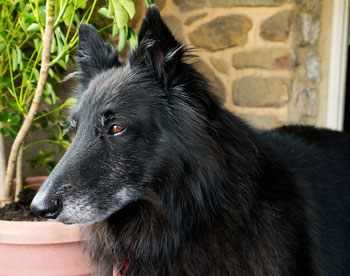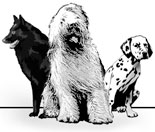Second Visit to Dr. Overall -- February 25, 2013
 Bing poses to show of his sugar mouth and pencil thin
Bing poses to show of his sugar mouth and pencil thin white eye brows.
I won’t rehash Bing’s history here, as you can read all the previous blogs. I think we have managed Bing’s behavior really well in the past 5 years, but I liked the excuse to see Karen, and thought it would be a good idea to talk some more about him, to see if I could glean some more insight from her. I didn’t realize how important this meeting would be, how critical it would be in helping me to really understand him. And I had NO idea that it would really change the way I think about him.
Karen’s first observation was really cute. He marched into her house, looked around, looked at her, and she noticed his Sugar Mouth (white around his mouth). Then she noticed his white eyebrows…it’s like they were penciled in in a thin white line. Throughout the session I got the impression that she kinda liked the guy. Her second observation was that for a 7 ½ year old, he is more hyper than she would think he should be. I thought that was really interesting, because I kinda think he’s normal!
We reviewed his medication and events which transpired in the past five years. Then we launched into his diagnosis and behavior. Bing was diagnosed five years ago with Generalized Anxiety Disorder and Fear (two separate diagnoses). She told me then that Generalized Anxiety Disorder is a vastly overdiagnosed problem, but he actually has it. She said that there are things he worries about, and the worry causes the anxiety. The fact that he has learned so many things IN SPITE OF the anxiety is really amazing. Bing really does have a huge repertoire of behaviors; he does rally, agility, competition obedience, tricks. He is very bright and loves to work. He is a fantastic hiking companion and will not allow us to get lost. His recall is immediate and very consistent (but not perfect).
She explained that we need a certain amount of stress to be able to learn, and that learning takes place on a cellular level. Not enough stress, and the neurotransmitters will not trigger the synthesis of a new receptor protein. Too much stress, and the learning will not generalize and therefore will not be remembered. This is because the cortisol terminates the production of the receptor protein. You have to have the right amount of stress to learn, and just the right amount to generalize. For dogs like Bing, there is often too much cortisol in his body for him to learn and generalize.
We then discussed the things that are difficult for Bing: something closing in on him…a van door, a crate door, a yard gate; people touching him or reaching for him. These things cause him immense amounts of stress, and he reacts by screaming and shredding anything available (such as the seatbelt he shredded last Sunday in about 30 seconds while I and another person got into the van). With people, he will actually retract his lower eye lid (she clarified that he tenses his face muscles) to show Whale Eye and if the person doesn’t respond, he will snap. He snapped at someone a few weeks ago who forgot and petted him on the head (Yikes!) and he responded by pushing the person’s hand away, not by biting it). Karen thought that this event was really telling us that he is very capable of controlling the intensity of what he does. He KNOWS he is stressed, he does not want to act inappropriately, but he doesn’t have an alternative behavior in which to engage.
This all led us to a new exercise to do with Bing, which translates to Biofeedback. She started to teach him how to breathe to relax. She held a treat up in front of him. He’d focus on it, hold his breath, then flare his nostrils to catch a scent stream, and that is the point at which she would mark and reward the behavior. Essentially, she is teaching him how to take a breath and relax when he is tense about something. Once he gets it, we can add a cue to it and prompt him to do this in tense situations. We are practicing! You can imagine how you react when you become tense…you hold your breath. This exercise helps him to learn how to breathe to relax when he is tense.
That said, it does not mean that I should put him in harms’ way. Protecting him is critical. I should not even try to put him purposely in situations where he might need to react. Our trip out west this past summer was extremely difficult for him because we did not provide him with predictable environmental constructs. Every day was different, and he never knew that to expect. My plan now is to never do that to him again. But when we do find that we are in an unpredictable situation, I will be able to help him by cuing him to breathe, and he will, hopefully, learn to relax himself instead of act inappropriately by barking, screaming, shredding, or snapping.
Bing is on Gabapentin. It is in the Benzodiazepine class, but it is a cool and unusual drug because, in her words, it functions like a Trojan Horse. It is not metabolized by either the kidneys or the liver, or otherwise converted into something that is used. It simply fits receptors that inhibit excitement. In moderate amounts, this has an overall anxiolytic (anti-anxiety) effect. The wonderful part about this is that it has very few side-effects. We are increasing the dose, since he is on a dose so low that we could raise it many times before it falls within the therapeutic level.
I feel so much better knowing exactly what Gabapentin does. And I feel like I have a much better appreciation for what Bing goes through on a given day.
We talked about one more thing that I need to ask her more about. Apparently sometimes something happens in utero where the neurons become predisposed to experiencing touch as if it were pain. This can surface at any time….months or years into the dog’s life. Bing is completely intolerant to touch by anyone but me, mostly my husband, increasingly my daughter and a few select people when I am not around. As odd as it is, if he does, indeed, experience touch as pain, or fear that he will experience touch as pain, it really does behoove me to protect him from others at all costs. No sense in attempting to train something that is a wiring issue.
The depth of the information that we covered in an hour is astonishing and it will take me weeks to fully digest it. Suffice to say, I am thrilled that I decided to have another visit, and I plan to see Dr. Overall again in the fall.
Ali
Comment from Donna A.
Sara is a fearful dog and it seems so resistant to any type of behavioral treatment; at least any that is commonly used. This blog helps me to “get it” that it might be a bio-chemical or possibly a “wiring” issue but also that there are behavioral interventions such a teaching her to breathe when she is anxious. I didn’t fully understand about just how Gabapentin works and the rest of the information is all brand new to me. Thank you so much. I will be pursuing this with Sara’s vet regarding Gabapentin and also attempting to get more information and understand how to apply what is applicable to Sara. Thank you.
Comments about this blog, email pete@e-production.net, (your comments may be posted).
Bing Blog 63



